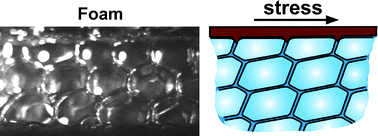The role of surfactant type and bubble surface mobility in foam rheology
Abstract
This paper is an overview of our recent understanding of the effects of

* Corresponding authors
a
Laboratory of Chemical Physics & Engineering, Faculty of Chemistry, Sofia University, 1 James Bourchier Ave.,1164, Sofia, Bulgaria
E-mail:
ND@LCPE.UNI-SOFIA.BG
Fax: (+359-2) 962 5643
Tel: (+359-2) 962 5310
b Unilever Global Research Center, Trumbull, Connecticut, USA
c Unilever Discover, Port Sunlight Laboratory, Quarry Road East Bebington, Wirral, UK
This paper is an overview of our recent understanding of the effects of

 Please wait while we load your content...
Something went wrong. Try again?
Please wait while we load your content...
Something went wrong. Try again?
N. D. Denkov, S. Tcholakova, K. Golemanov, K. P. Ananthpadmanabhan and A. Lips, Soft Matter, 2009, 5, 3389 DOI: 10.1039/B903586A
To request permission to reproduce material from this article, please go to the Copyright Clearance Center request page.
If you are an author contributing to an RSC publication, you do not need to request permission provided correct acknowledgement is given.
If you are the author of this article, you do not need to request permission to reproduce figures and diagrams provided correct acknowledgement is given. If you want to reproduce the whole article in a third-party publication (excluding your thesis/dissertation for which permission is not required) please go to the Copyright Clearance Center request page.
Read more about how to correctly acknowledge RSC content.
 Fetching data from CrossRef.
Fetching data from CrossRef.
This may take some time to load.
Loading related content
